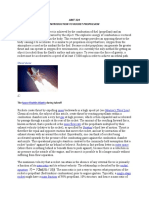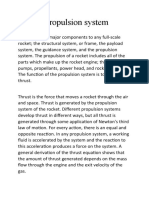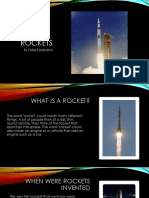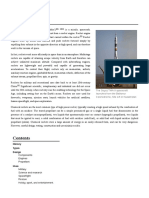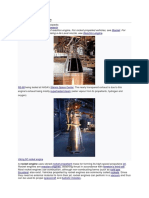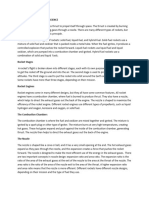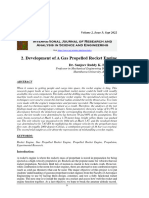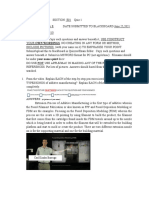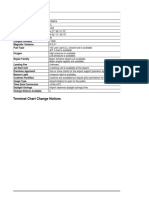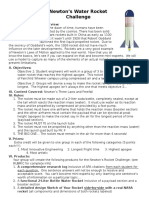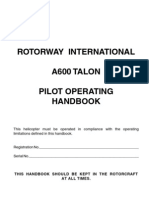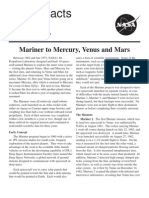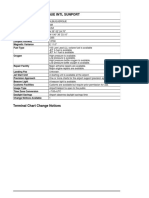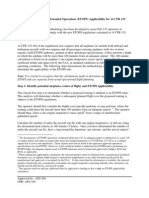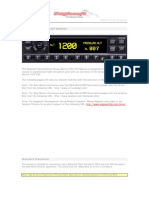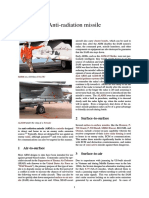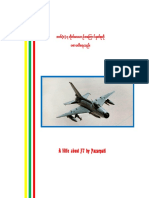The evolution of the rocket has made it an indispensable tool in the exploration of space.
For centuries, rockets have provided ceremonial and warfare uses starting with the ancient Chinese, the first to create rockets.
A rocket is a missile, spacecraft, aircraft or other vehicle that obtains thrust from a rocket engine. Rocket engine exhaust is formed entirely from propellants carried within the rocket before [1] use. Rocket engines work by action and reaction. Rocket engines push rockets forward simply by throwing their exhaust backwards extremely fast.
Like most engines, rockets burn fuel. Most rocket engines turn the fuel into hot gas. The engine pushes the gas out its back. The gas makes the rocket move forward. A rocket is different from a jet engine. A jet engine needs air to work. A rocket engine doesn't need air. It carries with it everything it needs. A rocket engine works in space, where there is no air. There are two main types of rocket engines. Some rockets use liquid fuel. The main engines on the space shuttle orbiter use liquid fuel.. Other rockets use solid fuels. On the side of the space shuttle are two white solid rocket boosters. They use solid fuels. Fireworks and model rockets also fly using solid fuels.
How Does a Rocket Work? In space, an engine has nothing to push against. So how do rockets move there? Rockets work by a scientific rule called Newton's third law of motion. English scientist Sir Isaac Newton listed three Laws of Motion. He did this more than 300 years ago. His third law says that for every action, there is an equal and opposite reaction. The rocket pushes on its exhaust. The exhaust pushes the rocket, too. The rocket pushes the exhaust backward. The exhaust makes the rocket move forward.
When Were Rockets Invented? The first rockets we know about were used in China in the 1200s. These solid rockets were used for fireworks. Armies also used them in wars. In the next 700 years, people made bigger and better solid rockets. Many of these were used for wars too. In 1969, the United States launched the first men to land on the moon using a Saturn V rocket.
Types
Vehicle configurations
�Rocket vehicles are often constructed in the archetypal tall thin "rocket" shape that takes off vertically, but there are actually many different types of rockets including: tiny models such as balloon rockets, water rockets, skyrockets or small solid rockets that can be purchased at a hobby store missiles space rockets such as the enormous Saturn V used for the Apollo program rocket cars rocket bike rocket-powered aircraft (including rocket assisted takeoff of conventional aircraft- JATO) rocket sleds rocket trains rocket torpedos rocket-powered jet packs rapid escape systems such as ejection seats and launch escape systems space probes
General Parts
The study of rockets is an excellent way for students to learn the basics of forces and the response of an object to external forces. In flight, a rocket is subjected to the forces of weight, thrust, and aerodynamics. On this slide, we have removed the outer "skin" so that we can see the parts that make a rocket. There
�are many parts that make up a rocket. For design and analysis, engineers group parts which have the same function into systems. There are four major and general systems in a full scale rocket; the structural system, the payload system, the guidance system, and the propulsion system. The structural system, or frame, is similar to the fuselage of an airplane. The frame is made from very strong but light weight materials, like titanium or aluminum, and usually employs long "stringers" which run from the top to the bottom which are connected to "hoops" which run around around the circumference. The payload system of a rocket depends on the rocket's mission. The earliest payloads on rockets were fireworks for celebrating holidays. The payload of the German V2, shown in the figure, was several thousand pounds of explosives. The guidance system of a rocket may include very sophisticated sensors, onboard computers, radars, and communication equipment to maneuver the rocket in flight. Many different methods have been developed to control rockets in flight. The V2 guidance system included small vanes in the exhaust of the nozzle to deflect the thrust from the engine. Modern rockets typically rotate the nozzle to maneuver the rocket. The guidance system must also provide some level of stability so that the rocket does not tumble in flight. As you can see on the figure, most of a full scale rocket is propulsion system. There are two main classes of propulsion systems, liquid rocket engines and solid rocket engines. The V2 used a liquid rocket engine consisting of fuel and oxidizer (propellant) tanks, pumps, a combustion chamber with nozzle, and the associated plumbing. The Space Shuttle, Delta II, and Titan III all use solid rocket strap-ons. The various rocket parts described above have been grouped by function into structure, payload, guidance, and propulsion systems. There are other possible groupings. For the purpose of weight determination and flight performance, engineers often group the payload, structure, propulsion structure (nozzle, pumps, tanks, etc.), and guidance into a single empty weight paramater. The remaining propellant weight then becomes the only factor that changes with time when determining rocket performance.
�Cohete espacial: vehculo dotado de un motor de propulsin a chorro que puede desplazarse en el espacio. Torre de escape: torre que le permite a los astronautas retirarse en caso de peligro. Mdulo lunar: medio de transporte para viajar por la luna. Reservorio de hidrgeno lquido: parte del cohete que contiene las reservas de hidrgeno lquido. Propulsor J-3: parte de la tercera etapa que lo separa de la segunda etapa. Propulsor J-2: parte de la segunda etapa que lo separa de la primera etapa. Reservorio de oxgeno lquido: parte del cohete que contiene las reservas de oxgeno lquido para uso como combustible del motor. Reservorio de keroseno: parte del cohete que contiene las reservas de keroseno para uso como combustible del motor. Estabilizador: parte del cohete que lo mantiene estable durante el despegue. Tobera: parte del cohete por la que el fluido que corre le permite incrementar la velocidad. Propulsor F-1: parte del cohete que le permite despegar. Primera etapa: parte del cohete ms cercana al suelo durante el despegue. Compartimiento intermedio: parte del cohete que conecta la primera y segunda etapa.
�Segunda etapa: segunda parte del cohete a partir del suelo. Tercera etapa: parte del cohete que lleva la carga til. Carga til: parte que debe salir al espacio.
Specific Parts Rocket: vehicle equipped with a jet engine and used for space travel. Launch escape system: tower that enables the astronauts to retreat in case of danger. Lunar module: means of transport for traveling on or around the moon. Liquid hydrogen: part of the rocket containing reserves of liquid hydrogen. J-3 engine: part of the third stage that detaches it from the second stage. J-2 engine: part of the second stage that detaches it from the first stage. Liquid oxygen: part of the rocket that contains reserves of liquid oxygen for use as engine fuel. Kerosene: part of the rocket that contains reserves of kerosene for use as engine fuel. Stabilizing fin: part of the rocket that keeps it steady during takeoff. Nozzle: part of the rocket through which flowing fluid enables it to gain speed. F-1 engine: part of the rocket that enable it to take off. First stage: part of the rocket closest to the ground during takeoff. Inter-stage: part of the rocket connecting the first and the second stages. Second stage: second part of the rocket from the ground. Third stage: part of the rocket that carries the payload. Payload: that which is to be in space.
�Uses
Rockets or other similar reaction devices carrying their own propellant must be used when there is no other substance (land, water, or air) or force (gravity, magnetism, light) that avehicle may usefully employ for propulsion, such as in space. In these circumstances, it is necessary to carry all the propellant to be used. However, they are also useful in other situations:
Military
Some military weapons use rockets to propel warheads to their targets. A rocket and its payload together are generally referred to as a missilewhen the weapon has a guidance system (not all missiles use rocket engines, some use other engines such as jets) or as a rocket if it is unguided. Anti-tank and anti-aircraft missiles use rocket engines to engage targets at high speed at a range of several miles.
�Science and research
Sounding rockets are commonly used to carry instruments that take readings from 50 kilometres (31 mi) to 1,500 kilometres (930 mi) above the surface of the Earth, the altitudes between those reachable by weather balloons and satellites.
Spaceflight
Spacecraft delivered into orbital trajectories become artificial satellites, which are used for many commercial purposes. Indeed, rockets remain the only way to launch spacecraft into orbit and beyond.
Rescue
Solid rocket propelled ejection seats are used in many military aircraft to propel crew away to safety from a vehicle when flight control is lost.
Hobby, sport and entertainment
Hobbyists build and fly a wide variety of model rockets. Many companies produce model rocket kits and parts but due to their inherent simplicity some hobbyists have been known to make rockets out of almost anything. Rockets are also used in some types of consumer and professional fireworks.
Current day
Rockets remain a popular military weapon. However rockets are often used by helicopters and light aircraft for ground attack, being more powerful than machine guns, but without the recoil of a heavy cannon and by the early 1960s air-to-air missiles became favored. Commercially, rocketry is the enabler of all space technologies particularly satellites, many of which impact people's everyday lives in almost countless ways. Scientifically, rocketry has opened a window on the universe, allowing the launch of space probes to explore the solar system and space-based telescopes to obtain a clearer view of the rest of the universe.





